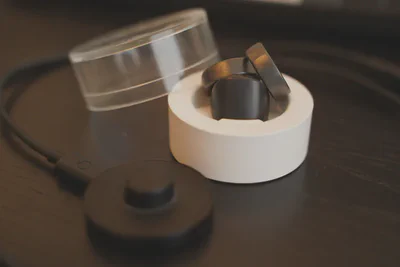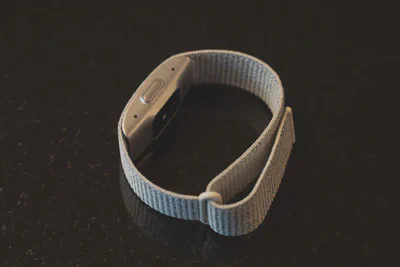Amazon Halo band review or the best minimalistic fitness tracker of early 2022
At the beginning of last year, my Oura fitness ring died on me for the second time within 26 months, just outside of the warranty period of twelve months, which meant that Oura wouldn’t replace it this time. Both times, it was the battery. I’ve been with Oura from the first version; I flew to Helsinki to get my first Oura ring. I love the design and the form factor, but the fact that it dies so fast makes me question whether it is worth it. $300 for a device that barely lasts a year is a bit too much. And recently, they started to charge a $6 monthly subscription on top of the price of the ring.

I was forced to pick up a new fitness tracker and decided not to go with the Oura ring this time because of the following:
- It dies fast and has a short warranty period.
- Expensive, $300 + $6/mo for a device that lasts for about a year.
- Ring is not the best form factor for a fitness device to wear when exercising. It gets in the way when I do pull-ups or exercise with dumbbells — this makes me take it off and put it in my pocket, but this way, it doesn’t track the exercise automatically.
Before I embarked on searching for my next fitness tracker, I listed my requirements. I needed a fitness tracker that:
- has a minimalistic, modern design
- ideally, doesn’t have a screen: the benefits of not having a screen are that it contributes to the minimalistic design, doesn’t introduce distractions, contributes to the battery lasting longer, and makes the device look better when worn simultaneously with the watch
- decent battery life: Apple Watch-style one day of battery life is unacceptable, at least a few days, the more, the better; five-ish days is reasonable
- decent sleep tracking: Oura was great at this, it will be hard to match, but it should be close to the level set by Oura ring
- basic activity tracking: I want it to set activity goals and track the progress automatically
What did I consider?
- Motiv Ring — discontinued, and ring isn’t a perfect fitness tracking format for me
- Jawbone Up — ideal design, but pretty hard to find one nowadays since it is ten years old; the device is discontinued
- Garmin vívofit 4 — small, impressive 1+ year battery life, ok design, but has a display, and the reviews didn’t make it sound like it is perfect at sleep tracking
- Misfit Ray — attractive design, but there were a lot of reviews saying that it gets scratched easily, that the app is mediocre, and that it isn’t good for sleep tracking
- Whoop — looks good, satisfies my requirements on paper, but the membership of €18-30 per month makes it pricey

In the end, I chose Amazon Halo. It checked all the boxes for me. It is priced reasonably and has some features that I didn’t think about initially, which are a great bonus to have:
- a curated collection of professional workouts that I can do at home
- body composition scan that determines your fat percentage
- an AI-based body movement assessment that scores stability, mobility, and posture independently and, in my opinion, does a pretty good job at it
Amazon Halo is priced at $100 + $4/mo starting from the seventh month. Compare the Oura device price with the Halo price + subscription. I can use Amazon Halo for four years and eight months for the same price. And this calculation was made without accounting for the Oura ring subscription cost. I got my Halo for $55 on sale.
Given how great this device is, I am surprised that it is rated only 3.7 out of 5 on Amazon. After reading the reviews, I found out that a lot of people are complaining about the invasiveness of the “tone analysis” feature, are worried about the privacy of the photos taken for the body composition scan, and are complaining about the device being too demanding of them so they can’t even come close to reaching their weekly activity goal.
I genuinely feel bad for Amazon Halo for receiving that many complaints. None of these is an issue to me, and the latest point is even a benefit because I was looking for extra motivation to move and exercise more. Let me elaborate on each of the complaints.
Tone analysis. When this feature is enabled, the band listens to your conversations and sends voice recordings to your phone, where they are analyzed for tone. You can also give the Amazon Halo app access to your calendar to map your tone to specific meetings and events. The feature sounds nice, but it wasn’t useful for me when I spoke English (my tone was marked as “neutral” most of the time), and it didn’t work at all for me when I spoke Russian. It also makes the band last only for about two days. So, after playing with it for a few weeks, I turned it off, and other people who are concerned about this feature can too. Actually, it’s turned off by default. With the feature turned off, the band lasts for about five days, which makes it match my ideal battery life requirement.
Body composition scan. This feature requires you to undress down to your underwear and to position your phone in a way that the camera is able to see you, head to toe. After that, you have to stand in front of the camera and rotate your body in place. Then, the pictures are sent to Amazon servers to construct a 3D model of your body and to perform an AI-powered body composition analysis. According to Amazon marketing materials, the feature is almost as good as specialized equipment used for that purpose in fitness centers. In the app, you can also see how your body would change if you lose or gain fat. If you are concerned about your photos being sent to Amazon servers, you may skip this feature. It’s a great fitness tracker worth its money even without it.
The last issue people complain about is that the band is very demanding. I remember reading a review on Amazon where the reviewer complained that they had trouble achieving any points at all in a day because the few points they got during their morning walk were then deducted as an inactivity penalty. The thing is, the band allows you to be stationary for only eight hours a day, for each extra hour, it deducts an activity point. I think that this is a great feature because a healthy lifestyle is not only about momentary exercises but also about consistency. I feel like the band is pretty generous with giving out activity points; I got 45 activity points today for a two-hour walk through the city. And, usually, it takes my girlfriend, who uses a Garmin Lily, much more activity to achieve the same 150 weekly heart points recommended by the American Heart Association.
Overall, I highly recommend this band. In my opinion, this is the best minimalistic fitness tracker on the market right now, 9/10 — I wish it lasted a year on one charge and didn’t have a subscription fee :-P